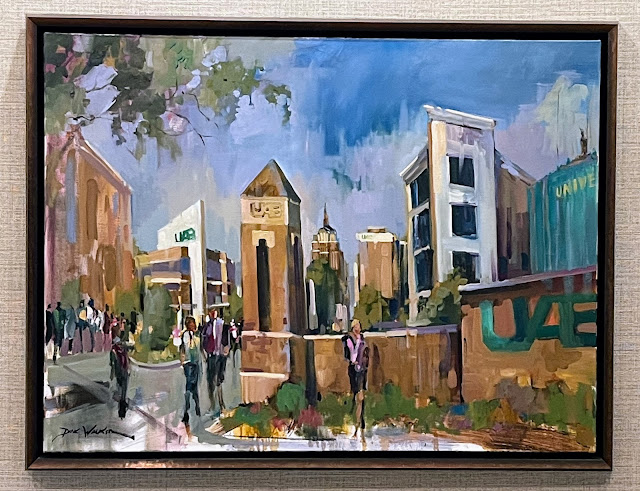Today I'm posting a piece by a guest author, Dr. James Boogaerts of the UAB School of Medicine. He discusses the way in which the specialties of cardiology and cardiovascular surgery came to the state-specifically at what is now the UAB Heersink School of Medicine-after World War II.
A more detailed look at some of this history can be found in
Holman WL, Deas DS Jr, Kirklin JK. Cardiothoracic Surgery at the University of Alabama at Birmingham (UAB): A Legacy of Innovation, Education, and Contributions. Semin Thorac Cardiovasc Surg. 2020 Winter;32(4):606-616
A good overview of the state's medical history is Howard Holley's 1983 book, A History of Medicine in Alabama.
I would like to thank Dr. Boogaerts for allowing me to add his piece to AlabamaYesterdays. I have added a few images and notes at the end.
Much of Alabama's medical history is poorly documented. I've written quite a few related posts on this blog; you can find links to some of them here.
History of Cardiology and Cardiovascular Surgery
- Intersections in
Alabama -
Received his Ph.D. & M.D. from LSU Medical Center in New Orleans, completed his residency and a cardiology fellowship at UAB 1984-90
Dr. John Burrett, first
cardiologist in Alabama, arrived in Birmingham in 1946. Dr. Burrett had lived
on East 88th Street in Manhattan when he graduated in 1937 from New
York Medical College, where his father was dean. He subsequently moved to
Boston and worked in the physiology lab of Dr.
Walter B. Cannon at Harvard, then trained as a cardiology fellow with Dr.
Paul Dudley White, who had begun the first cardiology service in the U.S.,
at the Massachusetts General Hospital, in 1916. Dr. Burrett and Dr. White co-published a
research article on congenital heart disease in 1945.
John Burrett
One question regarding the John Burrett
story is why an established physician from the Northeast would move to the
South in the mid-40s and join the faculty of the Medical College of Alabama, which had moved in 1945 from Tuscaloosa to Birmingham.
The facts are that Dr. Burrett had met Dr. Joseph Donald, an Alabama
surgeon, during his military service and he had met and married a nurse, Clara
Bray, who was training in Manhattan. Her
home was in Orlando, Florida, but her extended family was from Georgia.
Tinsley Harrison
Al Blalock
Vivien Thomas
Tinsley Harrison came to UAB in 1950. His roommate and close
friend during med school and residency at Johns Hopkins (in the 1920s) was Alfred Blalock, who performed the
first-ever elective cardiovascular surgery on November 29, 1944, with VivienThomas talking him through the operative procedure. Two decades later, Levi Watkins - by happenstance - followed the pathway of Vivien
Thomas to Vanderbilt and later to Johns Hopkins. Levi Watkins enrolled in Vanderbilt School of
Medicine in 1966 and then moved through
Johns Hopkins as a surgical resident and joined the faculty at Hopkins as a
cardiac surgeon.
Dr. Levi Watkins
Luther Hill
Michael DeBakey
John W. Kirklin
Earlier, Luther Hill had performed the first successful emergency cardiac surgery in the U.S. - in Montgomery, Alabama in 1902 - when he sutured the heart of patient with a penetrating stab wound. Michael DeBakey, while a medical student at Tulane in New Orleans, pioneered use of the roller pump for blood transfusions in the 1930s; the roller pump was later used in the first heart-lung bypass machine in 1953. In 1955, while at Mayo Clinic, significant improvements were made by John Kirklin and his team. Kirklin was recruited to UAB in Birmingham in 1966.
Andreas Gruentzig arrived at Emory School of Medicine in Atlanta in
1980.
One of his cardiology fellows was
Gary Roubin.
While on faculty at Emory, Roubin pioneered development of the intracoronary stent.
He came to UAB in
1989.
Dr. Gary Roubin
Contributions of physicians working in
Alabama, Louisiana, Tennessee, and Georgia - Luther Hill, Tinsley Harrison, Michael Debakey, Al Blalock, Vivien Thomas, John Kirklin, Levi Watkins,
Andreas Gruentzig, and Gary Roubin - are thus connected to
both early and recent pivotal events in cardiology and cardiovascular surgery.
See *pump* and *balloon* and *stent* pages

Article by Burrett, White and others published in the July 1942 issue of the Journal of Clinical Investigation while Burrett worked in White's lab in Boston.
After he joined the Medical College of Alabama faculty in 1946, Dr. Burrett published a few articles in his area of expertise. two of them are listed below. The one above appeared in the October 1947 Jefferson-Hillman Hospital Bulletin and had a different format. As noted on the first page above, he reviewed the "so-called orthodox therapy" on myocardial infarction [heart attack]. His talk at the house staff bi-monthly seminar was followed by extensive discussion of his remarks.
1: BURRETT JB, KAHN SS. Incidence of a very slow ventricular rate in a young adult with A-V block and Stokes-Adams attacks. Jefferson-Hillman Hosp Bull. 1947 Jul;1(3):56-64. PMID: 20252035.
2: BURRETT JB. Nonsurgical congenital heart disease. J Med Assoc State Ala. 1950 Sep;20(3):79-81. PMID: 15437143



















































